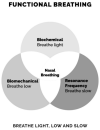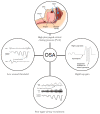Breathing Re-Education and Phenotypes of Sleep Apnea: A Review
- PMID: 33530621
- PMCID: PMC7865730
- DOI: 10.3390/jcm10030471
Breathing Re-Education and Phenotypes of Sleep Apnea: A Review
Abstract
Four phenotypes of obstructive sleep apnea hypopnea syndrome (OSAHS) have been identified. Only one of these is anatomical. As such, anatomically based treatments for OSAHS may not fully resolve the condition. Equally, compliance and uptake of gold-standard treatments is inadequate. This has led to interest in novel therapies that provide the basis for personalized treatment protocols. This review examines each of the four phenotypes of OSAHS and explores how these could be targeted using breathing re-education from three dimensions of functional breathing: biochemical, biomechanical and resonant frequency. Breathing re-education and myofunctional therapy may be helpful for patients across all four phenotypes of OSAHS. More research is urgently needed to investigate the therapeutic benefits of restoring nasal breathing and functional breathing patterns across all three dimensions in order to provide a treatment approach that is tailored to the individual patient.
Keywords: breathing re-education; dysfunctional breathing; myofunctional therapy; obstructive sleep apnea; phenotypes.
Conflict of interest statement
Patrick McKeown is a Buteyko Breathing Educator, the inventor of MyoTape® and the owner of
Figures





References
-
- Yamauchi M., Tamaki S., Yoshikawa M., Ohnishi Y., Nakano H., Jacono F.J., Loparo K.A., Strohl K.P., Kimura H. Differences in breathing patterning during wakefulness in patients with mixed apnea-dominant vs. obstructive-dominant sleep apnea. Chest. 2011;140:54–61. doi: 10.1378/chest.10-1082. - DOI - PMC - PubMed
Publication types
LinkOut - more resources
Full Text Sources
Other Literature Sources
Research Materials

